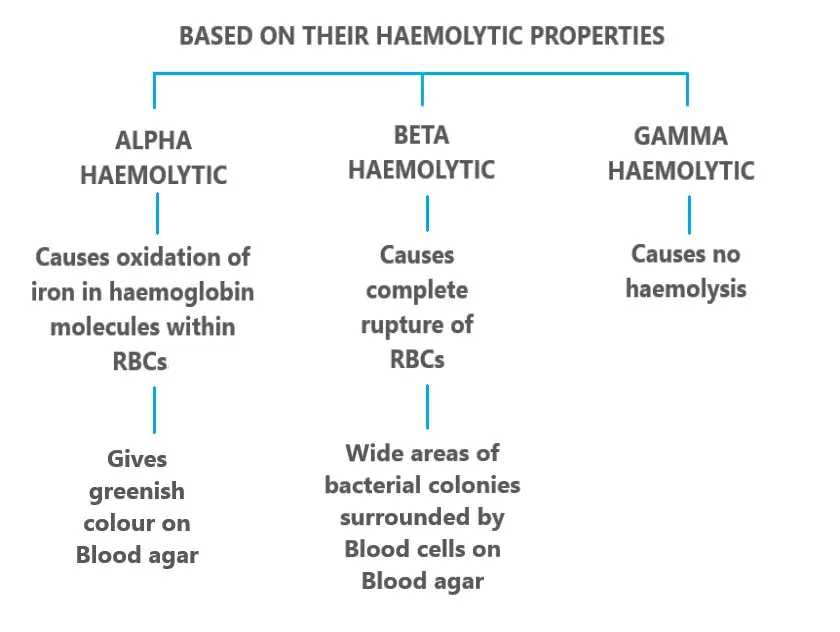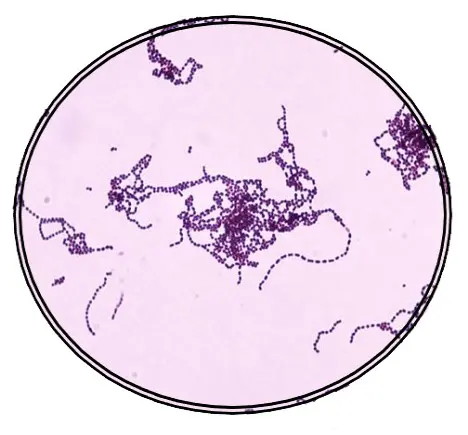
Streptococcus pyogenes is a Gram-positive bacterium.
They belong to the family Streptococcaceae.
The term was introduced by a surgeon Albert Theodor Billroth in 1877.
The word “Strepto” is of Greek origin which means “Easily Twisted”, where as “Coccus” is a Latin word which means “Grain, Seed or Berry”.
More than 50 species of streptococci have been identified.
Most of them are Oxidase and Catalase negative.
Many are Facultative anaerobes (can grow both aerobically and anaerobically).
Not all the species of streptococci are pathogenic.
Many of them form the symbiotic habitat in the mouth, skin, intestine and upper respiratory tract.
They are a necessary ingredient in producing swiss cheese.
Table of Contents
ToggleCLASSIFICATION OF STREPTOCOCCUS

REFERENCE
β-Haemolytic streptococci are further classified by Lancefield Grouping.
This is a serotype classification that is,
Identifying specific carbohydrate present on the bacterial cell wall.
There are 21 types of streptococci that has been identified named as Lancefield group A to W (excluding I and S).
This classification system was developed by Rebecca Lancefield who was a scientist from the Rockefeller university.
The medically important groups are,
- Alpha-Haemolytic streptococci
- Streptococcus pneumoniae
- Streptococcus viridans
- Beta-Haemolytic streptococci of Lancefield groups A and B.
STREPTOCOCCUS PYOGENES/ GROUP A STREPTOCOCCUS (GAS)
INTRODUCTION
- They are spherical, Gram-positive bacteria.
- Typically appear in chains.
- They are responsible for great variety of diseases than any other group of bacteria.
- They produce several harmful extracellular substances that can destroy pathogenic cells, digest the connective tissues of host (causing necrosis) or digest the fibrin of blood clots.
MORPHOLOGY OF STREPTOCOCCUS
- Species of Gram-positive bacteria.
- Family- Genus streptococcus.
- Round bacteria, linked in chains.
- Chains are longer in liquid media than in solid media.
- They are non-motile, non-sporing and capsulated cocci.
- Size- 0.5 to 1 µm in diameter.

CULTURAL CHARACTERISTICS
- They are Haemolytic bacteria (Causes complete rupture of red blood cells).
- Aerobic and facultative anaerobes.
- Required optimum temperature for growth is 37°C.
- They grow on blood agar producing β- haemolysis.
- They can grow rapidly on Enriched media with whole blood, serum, ascitic fluid or glucose.
BIOCHEMICAL REACTIONS
- They ferment lactose, glucose, salicin, sorbitol, maltose, dextrin etc.
- They are catalase negative.
- They do not liquefy gelatine.
- They do not ferment ribose.
RESISTANCE
- They can be easily destroyed by heat at 56°C for 70-80 minutes.
- They can survive in dust for many weeks (away from sunlight).
- They are resistant to crystal violet.
- Susceptible to sulphonamides.
- Highly sensitive to Bacitracin.
VIRULENCE/ PATHOGENIC FACTORS
Virulence factors can be classified into three
- Cell wall antigens
- Toxins
- Enzymes

CELL WALL ANTIGENS
Cell wall of S. Pyogenes is made up of,
- Inner thick layer of peptidoglycan which provides rigidity and induces inflammatory response.
- Middle layer of C- Carbohydrate antigen.
- Outer layer of protein and Lipoteichoic acid which helps to adhere the surfaces.
Outer protein layer
- There are many protein antigens like M, T and R proteins that have been identified on the outer layer of S. Pyogenes.
- The proteins and other cell wall antigens play an important role in the pathogenesis of Rheumatic fever.
- M protein- Important virulent factor, Antiphagocytic, helps to adhere to host epithelial cells.
- Antibody to M protein is protective in nature and promotes phagocytosis.
- Other antigens are the T and R proteins but, they are not pathogenic.
Capsule
- Some strains of Group A streptococcus are capsulated.
- These capsules are made up of hyaluronic acid.
- They produce mucoid colonies.
- Capsule is antiphagocytic but not pathogenic.
- Capsule helps to colonize in the pharynx with the help of hyaluronic acid (By binding with a protein named cD44 present on the cell wall of pharyngeal epithelium).
TOXINS AND ENZYMES
There are more than 20 extracellular substances produced by S. Pyogenes.
Some of the important toxins and enzymes are described below.
- Streptokinase/Fibrinolysin
- It activates plasmin in blood which dissolves fibrin in clots, thrombi and emboli.
- This ultimately causes breakdown of fibrin barrier.
- This promotes spread of infection around the lesions.
- Streptodornase/ Deoxyribonucleases
- DNAses (types A, B, C, D) breaks down the DNA and stimulates an antibody response.
- This helps to liquefy pus.
- Erythrogenic toxins
- Causes generalized rash, fever and malaise.
- Are associated with pathogenesis of scarlet fever.
- Hyaluronidase
- It destroys hyaluronic acid which is the adherent (cement) substance to the connective tissues.
- It helps in spreading the infection.
- Streptolysins
- These are of two types-
- Streptolysin O (oxygen labile)- Antigenic and stimulates anti streptolysin O (ASO) production. Presence of ASO antibody in patient’s serum confirms the presence of pathogen.
- Streptolysin S (oxygen stable)- Non-antigenic, does not stimulate antibody production. It hydrolyzes the Red blood cells and causes Beta-Haemolysis on blood agar.

PATHOGENESIS OF STREPTOCOCCUS
These bacteria are more invasive and can easily cause Septicemia.
They spread locally via Lymphatics and Blood stream.
Group A Streptococcus (GAS) produces both Suppurative (pus forming) and Non-suppurative manifestations.
SUPPURATIVE MANIFESTATIONS
Respiratory infections
- Examples- Streptococcal sore throat, follicular tonsillitis, pharyngitis, otitis media, mastoiditis, Ludwig angina, suppurative adenitis, meningitis etc.
- As secondary invader, they can cause influenza, empyema or bronchopneumonia.
Skin infections
- They can cause suppurative infections like erysipelas and impetigo.
- Impetigo in children may lead to glomerulonephritis.
Scarlet fever
- Erythrogenic toxins produced by strains of streptococcus causes sore throat and erythematous rashes especially in children (uncommon in tropical areas).
Puerperal sepsis
- Infection of uterus by streptococcus pyogenes after delivery or abortion leads to endometritis associated with bacteremia.
NON-SUPPURATIVE MANIFESTATIONS
May occur 1 to 3 weeks after acute infection.
May caused by inadequately treated infection with Group A Streptococcal infection of the skin and respiratory tract.
They are,
- Post streptococcal glomerulonephritis (PSGN)
- Rheumatic fever (RF)
- Guttate psoriasis
- Reactive arthritis
- Paediatric autoimmune neuropsychiatric disorder (PANDAS)
Here we will discuss the most common diseases like Post streptococcal glomerulonephritis (PSGN) and Rheumatic fever (RF).
Post streptococcal glomerulonephritis (PSGN)
- Develops after 3 weeks of infection.
- Caused by nephritogenic strains of streptococci Group A of type 12 which is the most common cause (others are 2,4, 49, 52 and 57).
- Disease is characterized by fever, oedema, azotemia (elevated blood urea nitrogen-BUN), haematuria, elevation of blood pressure, low level of serum complement.
- Urine shows presence of blood, albumin and granular cast.
- This condition is due to Antigen-Antibody (Ag-Ab) complex deposition on the glomerular basement membrane (GBM).
- This disease is self-limited and resolves without any permanent damage (patients recover completely).
- However, few many die or get complicated with chronic glomerulonephritis or renal failure.
Acute Rheumatic Fever (RF)
- Develops after 1-4 weeks of throat infection, sore throat or respiratory infection with Group A streptococci.
- Characterized by fever, pancarditis, migratory polyarthritis, erythema marginatum and sometimes chorea.
- This is an autoimmune disease.The antigens present on body of streptococci are similar to the proteins present in the valves and muscles of heart. So, the antibodies produced against streptococci can also react with the heart (cross reactivity).This leads to cardiac damage.
- Rheumatic fever has marked tendency of recurrence.
- Every repeated infection adds to the cardiac damage.
- This can be prevented by administration of long acting penicillin as prophylaxis.
EPIDEMIOLOGY
- Streptococcus affects all age groups.
- 5-15% of humans carry Streptococcus Pyogenes or Streptococcus Aglactiae in their nasopharynx.
- Transmission via Cow’s milk, Eggs, or Potato salad.
- Onset of illness after infection- 1 to 3 days.
- Easily spread by droplets or contact with materials used by patients like clothes, utensils, furniture etc.
LABORATORY DIAGNOSIS
Specimens required for tests
Swabs from throat, nasopharynx, or from other lesions, pus swab, sputum, Cerebro Spinal Fluid, blood etc.
Haematological tests
- Considerable increase in Total Leucocyte Count.
- Differential leucocyte count shows increase in Neutrophil count (more than 80%).
- ESR Raised especially in rheumatic heart diseases.
Bacteriological methods
- Gram staining method– Smear shows the presence of cocci in chains.
- Blood culture– Shows complete haemolysis. Done for bacteremic infections like endocarditis and puerperal sepsis.
- Bacitracin test– Group A strains can be differentiated from other strains of streptococci (B, C, G) due to their sensitivity to bacitracin.
- Antigen detection test– Group A strain antigens can be rapidly detected from throat swab by ELISA or Agglutination tests.
- Serological tests– Used for diagnosis of post-streptococcal diseases like acute glomerulonephritis and acute renal failure.
ASO titre (Anti-streptolysin O)
- Useful for detection of Asymptomatic carriers of Streptococcus pyogenes.
- Antibodies are being developed in patient’s sera with suspected Streptococcal infection.
- Detection of high ASO Titre of 1/200 is indicative of streptococcal infection.
- You can read full detail on ASO (Antistreptolysin O) Titre Blood Test by following the link.
Dick test
This test is performed to find out the susceptibility of a person to Scarlet Fever.
TREATMENT
- Penicillin is the drug for treatment of staphylococcal diseases.
- Long acting Penicillin are given as prophylaxis to children having recurrent attacks of staphylococcal sore throat or rheumatic fever.
Hope that you find this post helpful, don’t forget to share with your friends.
